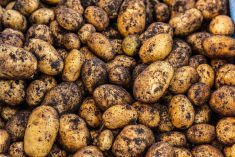The U.S. Department of Agriculture is projecting a rebound in U.S. corn and soybean yields in 2013 that, along with high planted acreage, opens the door to record-large crops and for prices to tumble from 2012-13 levels.
USDA forecast the U.S. corn crop at 14.350 billion bushels, up 35 per cent on the year, and soybean output at 3.405 billion bushels, up 13 per cent.
“A number of factors suggest that corn and soybean yields will be likely to return to trend,” Joseph Glauber, the USDA’s chief economist, said at the agency’s Agricultural Outlook Forum.
Read Also

Manitoba Ag Days plans star-studded speaker lineup
Dragons’ Den panellist Arlene Dickinson among speaker series highlight for 2026 Manitoba Ag Days in Brandon, alongside slate of agriculture experts.
Glauber projected that season-average U.S. corn prices for 2013-14 would fall 33 per cent to $4.80 per bushel and that soybean prices would tumble 27 per cent to $10.50.
Corn plantings are projected at 96.5 million acres, down slightly from last year’s 75-year high, and soybean plantings at 77.5 million acres, equalling the record high from 2009.
“The increase in production is not a surprise, but it does remind the trade this is a longer-term issue to consider,” said Rich Nelson, chief strategist for Allendale Inc. in McHenry, Illinois. “It reminds the trade that we will have a mountain of product at this fall’s harvest.”
Cotton acres down
The U.S. upland cotton area for 2013 was forecast at 9.8 million acres, down 2.3 million on the year, as farmers seek out crops that offer higher returns.
The all-cotton crop was forecast to fall almost 17 per cent, to 14 million bales.
Long-grain rice plantings are also likely to lose out to soybeans, with production seen down almost four per cent.
Glauber said the U.S. wheat crop was struggling, with much of the acreage in states such as Kansas and Nebraska in poor to very poor condition compared with a year ago.
Wheat production was forecast at 2.1 billion bushels, down 7.4 per cent.
“Spring rains will be especially important in the Great Plains this year, where elevated areas of abandonment are expected,” Glauber said.
Over all, growers will plant 255.3 million acres of the eight major U.S. field crops — corn, wheat, soybeans, rice, upland cotton, sorghum, barley and oats — this year, down one per cent from 2012 but slightly more than it projected last month.
The United States is coming off its worst drought in decades, which has generated some skepticism that farmers in key corn and soybean states will see trendline yields.
Upswing
But Glauber said conditions are on an upswing.
“We have already seen some improvement in the eastern Corn Belt,” he said. “While much of Indiana and Illinois were in drought throughout much of the summer, fall and winter rainfall has improved conditions there.”
Studies suggest little correlation in seasonal precipitation between one year and the next, Glauber said. “A dry summer in 2012 has little implication for summer precipitation in 2013,” he added.
A larger U.S. corn crop in 2013 will help push corn-for-ethanol usage to 4.675 billion bushels in 2013-14, up 175 million on the year but below 2011-12 levels, USDA said.
Several factors are likely to hamper further growth in corn use for ethanol, Glauber said, including the overall decline in U.S. gasoline consumption and weak export prospects because of increased competition from Brazil and potential restrictions on shipments to the EU.
“A dry summer in 2012 has little implication for summer precipitation in 2013.”














